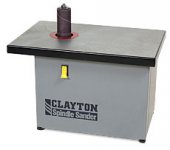An interesting discussion. I've had a few orbitals over the years: an old Oz-made B&D that was supposedly switchable from true orbital to linear actions. In reality there wasn't much discernable difference between modes. Its successor was a super-smooth electronic V/S Elu, which was both smoother & more aggressive @ the same time. Yet in terms of the actual work performed (i.e. abrasion) they were, due I suspect to their smaller (1/3 sheet) pads & orbital character, woefully slow.
I finally succumbed to temptation & purchased a super-aggressive 1/2 sheet Festo RS1C second hand. Being reduction gear driven (as opposed to direct drive) & with a substantially larger platen, it was much more aggro in use, more vibratory and much faster. The half sheet platen made it better, as Holmz has already said in regard to his Mafell equivalent, for flattening surfaces, but its 5mm of eccentricity tends to leave noticeable & difficult to remove semicircular striations, particularly with coarser grit papers. I was spending more time removing swirls with finer grits than I was on the actual task.
For flattening larger areas, a carefully applied belt sander, especially if fitted with a sanding frame, is the way to go. Linear striations will still be a problem, minimised by careful grit & belt selection & initial sanding @ 45 degrees to the grain followed up in subsequent finer grits parallel to the fibers. Follow up with a bigger random obit for a final smooth.
Whilst excellent if slow @ flattening edge-jointed planks on tables & benches, a big 1/2 sheet orbital becomes pretty unwieldy on smaller tasks. I've had a lot of window stiles & rails, glazing bars, doors & complex mouldings to strip. Festo/ol's Duplex LS130 promised much, but actually delivered little either. In use, it makes even a slow 1/3 sheet orbital seem speedy in comparison. For stripping paint in mouldings & bars, a combination of Skarsten & Bahco Carbide scrapers, a carefully applied Metabo LF 724 paint stripper & baby SXE400 random orbit and appropriately shaped hand pads with 90 & 45 degree corners and even paper wrapped around dowel rods will comprehensively outperform that stupid little LS130. Even a RO90 doesn't like these narrow profiles either: its poor balance and "large" size in comparison to conventional deltas & small Random Orbitals makes it just too much of a handful, and difficult to control in delicate mouldings.
In comparison with the alternatives most standard orbital sanders seem pretty irrelevant these days. I don't think I've felt the need to use one for 20 years or more. I ended up giving mine away. Too slow, too messy, too "scratchy". The only advantage they have over the alternatives is the cost of papers: you can buy rolls of painter's paper dirt cheap in comparison to discs which can be readily punched on the hole template once clamped to the sander. A mere fraction of the price of expensive velcro backed papers & discs.
For me the purchase 2nd gen. Rotex RO 150 made all these orbitals instantly redundant. In combination with a pair of delta sanders (Festo Deltex & Bosch GDA280) taking care of all those otherwise impossible to access nooks & crannies, and a couple of Metabo SXE400 80mm dia. mini random orbits for the concavities & curves, it has revealed the orbit sanders' weaknesses.
Random orbitals have the advantage of speed, aggression, smoothness & swirl free performance that are common characteristics of all orbitals that I've either owned or used. In just about every possible criteria except the cost of consumables standard rectangular orbital & linear sanders are struggling for relevance these days.

